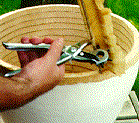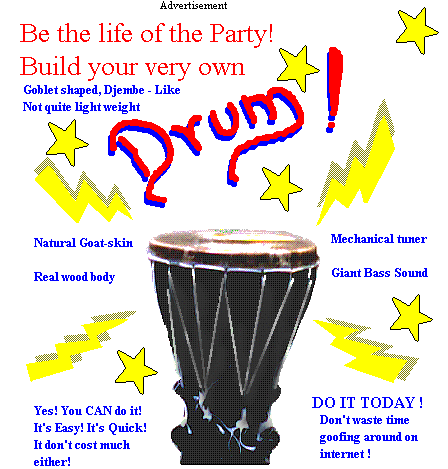This is the End.
Finishing up the Head
There are various ways to do this, but I usually do not have the patience to make some kindof fancy device for connecting the rope tension lines to the head other than making holes inthe skin to thread the rope through. I have a banjo that I made with a lamb skin head that used an elegant brass double compression ring system, but that WAS a banjo, and this isa hand drum so ...
 Holes are made in the skin using a leather punch. The holes are just above the tension ring so that whenthe rope is pulled taught, the loop along the outside edge of the head will pull down on the ring and notrip a larger hole in the skin. For this drum, I punched out sixteen (16) evenly spaced holes.
Holes are made in the skin using a leather punch. The holes are just above the tension ring so that whenthe rope is pulled taught, the loop along the outside edge of the head will pull down on the ring and notrip a larger hole in the skin. For this drum, I punched out sixteen (16) evenly spaced holes.
I purchased about 70 feet of medium weight nylon rope for the lacing. The fitted head was moistened with a little water to soften it up a bit and the lacing rope are looped through the holes. For this drum, 16 lengths of rope (about 4 feet each) were looped through each pair of holes. After all of the rope waslooped through, the head was placed onto the drum. This whole process was done rather quickly so the drum head did not get a chance to dry out. (It is best to keep it moistened enough to stretch the head over the tone ring properly).
The ends of the rope were tied onto the eye bolts down by the flange. This process proved rather messy as the knots sort of got out of hand at times (I only know how to tie three kinds of knots). I promised myself that I would work on the knots latter-- in the meantime, while they continued to hold I took out an open ended wrench and began to tighten the bolts on the end of the flange. Just a bit at first, going around the flange and tweaking each eye-bolt a little. As tension increased on the rope, I could judge just how even the rope tension was by the sound of the note as I plucked an individual rope like a bass fiddle (there was an 'open' string area between the top flange and the side of the drum that made this possible. This was one of those lucky undocumented features that you sometimes get ;^/).
This whole process went by rather quickly... I didn't stop to take pictures (sorry), but there is something about tuning an instrument, especially one that you have made by yourself. Anyway, before I did any drum head work at all, look what I did:
I had a white drum and I had it painted Black
One night, I had this dream about a black drum... so I spray painted the drum body with flat black paint. It has a kind of industrial look to it now. I think that flange especially looks good in black! Hey! I can do anything I want! It's my drum!!
So... All tightened up and ready to go, with all the pomp that goes with the WWW, I am pleased to introduce the following shameless gimmick:

Now what?
I believe that it will take some time now to work with it a little... do some tweaking here and there, and find the 'sweet spot' somewhere on that huge 55 square inch head. For now, I'm going to keep the past web pages as they are for a while, then condense them to an info page and include some WAV files of the drum in action.
So I'm outta here! And thanks for reading! Bye!
Click here to go back to the main DRUM page. Holes are made in the skin using a leather punch. The holes are just above the tension ring so that whenthe rope is pulled taught, the loop along the outside edge of the head will pull down on the ring and notrip a larger hole in the skin. For this drum, I punched out sixteen (16) evenly spaced holes.
Holes are made in the skin using a leather punch. The holes are just above the tension ring so that whenthe rope is pulled taught, the loop along the outside edge of the head will pull down on the ring and notrip a larger hole in the skin. For this drum, I punched out sixteen (16) evenly spaced holes.